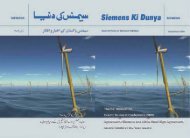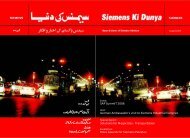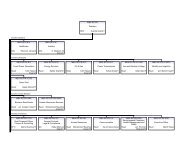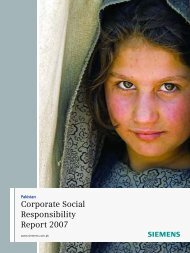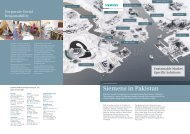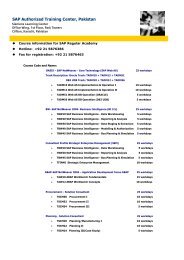Mohsin Annual Report-Final 1-91:Layout 1.qxd - Siemens Pakistan
Mohsin Annual Report-Final 1-91:Layout 1.qxd - Siemens Pakistan
Mohsin Annual Report-Final 1-91:Layout 1.qxd - Siemens Pakistan
Create successful ePaper yourself
Turn your PDF publications into a flip-book with our unique Google optimized e-Paper software.
Notes to the Financial Statements 1053.6 ImpairmentThe carrying value of the Company's non-financial assets other than inventories and deferred tax assets are reviewed at each reporting date todetermine whether there is any indication of impairment. If any such indications exist, the recoverable amount is estimated. An impairment lossis recognised if carrying amount of an asset exceeds its recoverable amount. Impairment losses are recognised in the profit and loss account.3.7 InvestmentsInvestments in subsidiaries are recognised at cost.3.8 Taxation3.8.1 CurrentProvision for current taxation is based on taxability of certain income streams of the Company under presumptive tax regime at the applicable taxrates and remaining income streams chargeable at current rate of taxation under the normal tax regime after taking into account tax credits andtax rebates available, if any.3.8.2 DeferredDeferred tax is provided using the balance sheet liability method, providing for temporary differences between the carrying amounts of assets andliabilities for financial reporting purposes and the amounts used for taxation purposes. The amount of deferred tax provided is based on theexpected manner of realisation or settlement of the carrying amount of assets and liabilities, using tax rates enacted or substantively enacted atthe balance sheet date.A deferred tax asset is recognised only when it is probable that future taxable profits will be available against which the deductible temporarydifferences can be utilised. Deferred tax assets are reduced to the extent that it is no longer probable that the related tax benefit will be realised.3.9 Long-term receivablesLong-term loans, trade debts, deposits and other receivables, except those on which mark-up is earned by the Company are discounted to theirpresent values.3.10 InventoriesInventories are valued at the lower of cost and net realisable value. Cost of finished goods, both manufactured and purchased, raw material andcomponents is determined on weighted average basis. The cost of work-in-process and finished goods includes direct materials, labour andapplicable production overheads. Goods-in-transit are valued at cost comprising invoice value and other expenses incurred thereon.Net realisable value is arrived at by considering the depletion span and technical obsolescence of inventories and the replacement cost thereof.3.11 Trade receivables3.11.1 Trade receivables are initially recognised at fair value and subsequently measured at amortised cost.3.11.2 Due against construction work in progress represents the gross unbilled amount expected to be collected from customers for contract workperformed to date. It is measured at cost plus profit recognised to date less progress billing and recognised losses. Cost includes all expendituresrelated directly to specific projects and an allocation of fixed and variable overheads incurred.3.11.3 Provision for impairment on trade receivables is established when there is objective evidence that the Company will not be able to collect allamount due according to original terms of receivables.3.12 Cash and cash equivalentsCash and cash equivalents comprise of cash in hand and deposits held with banks. Running finance facilities availed by the Company, which arerepayable on demand and form an integral part of the Company's cash management are included as part of cash and cash equivalents for thepurpose of the statement of cash flows.3.13 Segment reportingA segment is a distinguishable component of the Company that is engaged in providing related products or services (business segment), or inproviding products or services within a particular economic environment (geographical segment), which is subject to risks and returns that aredifferent from those of other segments. Segment information is presented in respect of the Company's business and geographical segments. TheCompany's primary format for segment reporting is based on business segments. The business segments are determined based on the Company'smanagement and internal reporting structure.Segment results, assets and liabilities include items directly attributable to a segment as well as those that can be allocated on a reasonable basis.Unallocated items comprise mainly investments (other than investment property) and related revenue, loans and borrowings and relatedexpenses, corporate assets and head office expenses, and income tax assets and liabilities.Segment capital expenditure is the total cost incurred during the period to acquire property, plant and equipment, and intangible assets other thangoodwill.



